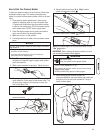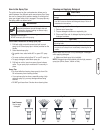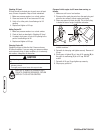
16 BRIGGSandSTRATTON.COM
Before Each Use
1. Check engine oil level.
2. Clean debris.
3. Check water inlet screen for damage.
4. Check high pressure hose for leaks.
5. Check detergent siphoning tube and filter for damage.
6. Check spray gun and nozzle extension assembly for
leaks.
7. Rinse out garden hose to flush out debris.
Pressure Washer Maintenance
Clean Debris
Daily or before use, clean accumulated debris from cleaning
system. Keep linkage, spring and controls clean. Keep area
around and behind muffler free from any combustible debris.
Inspect cooling air slots and openings on the pressure
washer. These openings must be kept clean and
unobstructed.
Pressure washer parts should be kept clean to reduce the
risk of overheating and ignition of accumulated debris.
• Use a damp cloth to wipe exterior surfaces clean.
• Use a soft bristle brush to loosen caked on dirt, oil, etc.
• Use a vacuum cleaner to pick up loose dirt and debris.
Check and Clean Inlet Screen
Examine the screen on the pump’s water inlet. Clean it if the
screen is clogged or replace it if screen is damaged.
Check High Pressure Hose
The high pressure hose can develop leaks from wear,
kinking, or abuse. Inspect the hose each time before using it.
Check for cuts, leaks, abrasions or bulging of cover, damage
or movement of couplings. If any of these conditions exist,
replace the hose immediately.
Check Detergent Siphoning Tube
Examine the filter on the detergent tube and clean if clogged.
The tube should fit tightly on the barbed fitting. Examine the
tube for leaks or tears. Replace the filter or tube if either is
damaged.
Check Gun and Nozzle Extension
Examine the hose connection to the spray gun and make
sure it is secure. Test the trigger by pressing the red button
and making sure the trigger “springs back” into place when
you release it. You should not be able to press the trigger
without pressing the red button. Replace spray gun
immediately if it fails any of these tests.
Nozzle Maintenance
A pulsing sensation felt while squeezing the spray gun
trigger may be caused by excessive pump pressure. The
principal cause of excessive pump pressure is a spray tip
clogged or restricted with foreign materials, such as dirt, etc.
To correct the problem, immediately clean the spray tip
following these instructions:
1. Shut off engine and turn off water supply.
2. ALWAYS point spray gun in a safe direction, press red
button and squeeze spray gun trigger to release
retained high water pressure.
3. Remove spray tip from end of nozzle extension.
4. Use a small paper clip to free any foreign material
clogging or restricting spray tip (A).
5. Remove nozzle extension from spray gun.
6. Using a garden hose, remove additional debris by back
flushing water through nozzle extension. Back flush
between 30 to 60 seconds.
7. Reinstall spray tip into nozzle extension.
8. Reconnect nozzle extension to spray gun.
9. Make sure garden hose is connected to water inlet.
Check that high pressure hose is connected to spray
gun and pump. Turn on water.
NOTICE
Improper treatment of pressure washer can damage it and
shorten its life.
• DO NOT insert any objects through cooling slots.
WARNING
The high pressure stream of water that this
equipment produces can cut through skin and its
underlying tissues, leading to serious injury and
possible amputation.
• NEVER repair high pressure hose. Replace it.
• Replacement hose rating MUST exceed maximum pressure
rating of unit.
A
WARNING
The high pressure stream of water that this
equipment produces can cut through skin and
its underlying tissues, leading to serious injury
and possible amputation.
Spray gun traps high water pressure, even when
engine is stopped and water is disconnected,
which can cause injury.
• Keep high pressure hose connected to pump and spray gun
while system is pressurized.
• ALWAYS point spray gun in safe direction, press red button and
squeeze spray gun trigger, to release high pressure, every time
you stop engine.


















